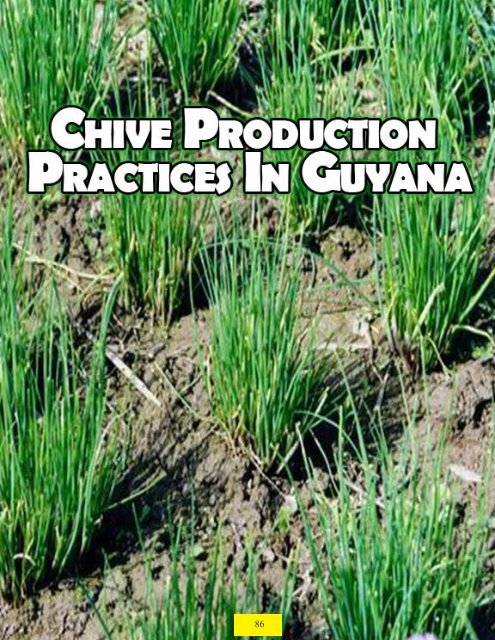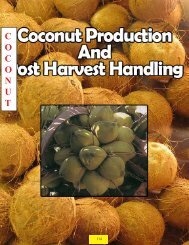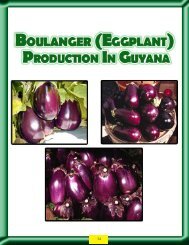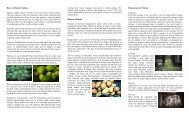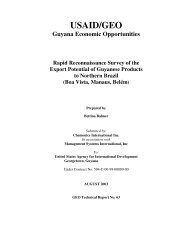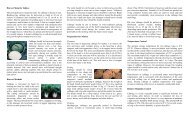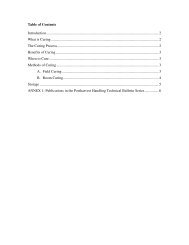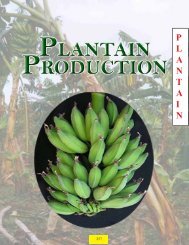Chive - Guyana Marketing Corporation
Chive - Guyana Marketing Corporation
Chive - Guyana Marketing Corporation
You also want an ePaper? Increase the reach of your titles
YUMPU automatically turns print PDFs into web optimized ePapers that Google loves.
86<br />
86
Introduction<br />
<strong>Chive</strong> is a member of the Allium family (Alliaceae) which includes other crops such as eschallot, onion,<br />
garlic, leek and bunching onion. The chive is the most widely distributed of the Allium species. The crop<br />
is a perennial, but in <strong>Guyana</strong> it is cultivated as an annual where the entire plant is harvested after an eight<br />
week growing cycle. Compared to onions and other alliums, chives have a strong tillering habit, forming<br />
dense clumps without well-formed bulbs.<br />
<strong>Chive</strong>s are grown mainly to satisfy the domestic market in <strong>Guyana</strong>. The herb has culinary and medicinal<br />
properties. The fresh leaves are used for making herbal butters and vinegar as well as a flavouring in<br />
salads, soups and soft cheeses. The oils (leaf extract) of the plant are known to lower blood levels of<br />
low-density lipoproteins. <strong>Chive</strong>s contain some iron and vitamins and can be used as mild antibiotics and<br />
laxative. The plants can also be grown for their attractive pinkish to mauve fragrant flowers.<br />
Cultivation<br />
Soil<br />
<strong>Chive</strong>s are tolerant to a wide range of soil conditions but fertile, well-drained medium loams with a pH<br />
of 6.0 - 7.0 are generally considered most suitable. Sandy soils can also be used if organic matter (30-40<br />
tons/ha) is incorporated. Clay soils need good drainage as well as organic matter (well-rotted pen<br />
manure) to improve the soil structure and fertility.<br />
Land preparation<br />
<strong>Chive</strong> is a shallow rooted crop (25-30 cm), so land preparation should not be deep. For virgin lands,<br />
plough the land twice down and across the field, to a depth of 20-25 cm, and harrow to obtain a fine tilth.<br />
Form beds 120 cm wide and 20 cm high. For continuously cultivated lands, fork and rake the land<br />
before planting.<br />
If nut grass, Cyperus rotundus, is present at land preparation, use Roundup at 3-4 tbs/gal 7-14 days<br />
before planting. The chemical is most effective when the weeds are actively growing.<br />
87 87<br />
C<br />
H<br />
I<br />
V<br />
E
C<br />
H<br />
I<br />
V<br />
E<br />
Liming<br />
Growth of chives is best on pH of 6.0 –7.0. Different soil types have different liming requirements.<br />
Limestone must be applied at least six weeks before planting for liming to be effective. Apply the<br />
limestone at the recommended rate and work into the soil to a depth of at least 15 cm.<br />
Planting Time and Method<br />
Although chives can be propagated from seeds, this method is not suitable for commercial cultivation<br />
because of the long crop cycle (11-15 weeks). The propagation of chives vegetatively by division of<br />
existing clumps of bulbs is the common practice. A spacing of 10 cm within rows and 10 cm across<br />
rows should be maintained.<br />
In the recommended spacing, two bulbs should be planted per hole. Thus to plant an area of 0.65 m 2 ,<br />
the quantity of bulbs required is 0.45 kg. For one hectare of pure stand chives, 6923 kg of planting<br />
material will be required.<br />
Increasing the planting density will result in depressed yields while decreasing the planting density will<br />
result in under-utilisation of land resources, thereby decreasing productivity.<br />
Fertiliser Application<br />
Fertiliser needs are related directly to the type and nutrient status of the soil. It is essential therefore<br />
that a soil analysis be conducted so that a precise recommendation for fertilizer application can be<br />
provided. Contact NARI for all soil analysis and fertilizer recommendations.<br />
In the absence of a soil analysis, the following is an approximate guide. Apply compound fertiliser<br />
(15:15:15) at the rate 414.7 kg/ha two weeks after planting. Apply urea at a rate of 138 kg/ha and<br />
muriate of potash at a rate of 103.6 kg/ha six weeks after planting.<br />
88 88
Irrigation<br />
<strong>Chive</strong>s respond well to regular irrigation, especially in the dry seasons. Watering in the morning is highly<br />
recommended.<br />
Weed Control<br />
<strong>Chive</strong> is poor competitor with weeds for water and soil nutrients - due to its shallow fibrous root system<br />
and the lack of an aerial canopy to shade out other vegetation.<br />
<strong>Chive</strong> is affected by many weeds but Hog bhagee, Portulaca oleracea L. is of major economic importance.<br />
It affects the plant from a very early stage; it grows vigorously competing with the plant and if not<br />
controlled, especially during the first three weeks of crop growth, it will smother the plants.<br />
P. oleracea can be controlled effectively with the broadleaf-specific chemical, Runstar at15 ml/2-3 gal<br />
water. Since this chemical does not affect straight vein weeds such as grasses, the most suitable method<br />
of control is removal by hand.<br />
Insect Pests and Their Control<br />
<strong>Chive</strong> is subject to pest attacks like any other crop. Daily inspection is recommended for insect pests.<br />
This should be done in the early morning or late afternoon. Apply insecticides only when the pests are<br />
present at levels that can reduce returns of the crop.<br />
1. Leafminer, Liriomyza sp.<br />
Economically, this is the most important pest affecting chive cultivation on the coast. The larvae of the<br />
leafminer feed between the leaf surfaces leaving irregular patterns of greenish-white mines on the leaves.<br />
This pest occurs year-round and it indiscriminately attacks plants of all stages of the crop cycle. Serious<br />
infestation causes yellowing, and subsequently browning of infected leaves.<br />
89 89<br />
C<br />
H<br />
I<br />
V<br />
E
C<br />
H<br />
I<br />
V<br />
E<br />
Irrigation<br />
<strong>Chive</strong>s respond well to regular irrigation, especially in the dry seasons. Watering in the morning is<br />
highly recommended.<br />
Weed Control<br />
<strong>Chive</strong> is poor competitor with weeds for water and soil nutrients - due to its shallow fibrous root<br />
system and the lack of an aerial canopy to shade out other vegetation.<br />
<strong>Chive</strong> is affected by many weeds but Hog bhagee, Portulaca oleracea L. is of major economic<br />
importance. It affects the plant from a very early stage; it grows vigorously competing with the plant<br />
and if not controlled, especially during the first three weeks of crop growth, it will smother the plants.<br />
P. oleracea can be controlled effectively with the broadleaf-specific chemical, Runstar at15 ml/2-3<br />
gal water. Since this chemical does not affect straight vein weeds such as grasses, the most suitable<br />
method of control is removal by hand.<br />
Insect Pests and Their Control<br />
<strong>Chive</strong> is subject to pest attacks like any other crop. Daily inspection is recommended for insect pests.<br />
This should be done in the early morning or late afternoon. Apply insecticides only when the pests<br />
are present at levels that can reduce returns of the crop.<br />
1. Leafminer, Liriomyza sp.<br />
Economically, this is the most important pest affecting chive cultivation on the coast. The larvae of<br />
the leafminer feed between the leaf surfaces leaving irregular patterns of greenish-white mines on the<br />
leaves. This pest occurs year-round and it indiscriminately attacks plants of all stages of the crop<br />
cycle. Serious infestation causes yellowing, and subsequently browning of infected leaves.<br />
90 90
Control<br />
Apply any one of the following:<br />
a) Leaf Guard (IGR) 75%. Mix 7g/18 litres water. For high insect population, repeat every seven days,<br />
for normal levels repeat every 14 to 21 days. Pre-harvest interval is seven to ten days.<br />
b) Padan 50 WSP. Mix 15 g in 4 to5 litres of water. Ensure a seven day interval between applications.<br />
Pre-harvest interval is ten days.<br />
c) Trigard 75% WP. Mix 2 g/3.8 litres water.<br />
It is advisable to alternate these chemicals to prevent the pest from developing resistance to the chemicals.<br />
2. Crickets<br />
Mole crickets, Scapteriscus spp. are present year-round and attack the crop indiscriminately. Crickets<br />
bite through the pseudostem of the chive destroying the entire plant. This is common during the first<br />
two weeks of planting.<br />
Control<br />
A bait comprising 0.9 kg (2 lb) freshly grated coconut and 3 ounces malathion and small handful of<br />
sugar or 2 tablespoons of molasses can be used to control crickets.<br />
This mixture is applied in the evening and evidence of control can be noticed the morning after. This<br />
method is highly effective in controlling the pest and one application is necessary per crop cycle.<br />
The pest can also be controlled by any of the following:<br />
Diazinon (Contact) 1-2 tbsp/4.5 L (1-2 tbsp/gal)<br />
Fastac (Contact) 1-2 tsp/4.5 L (1-2 tsp/gal)<br />
Admire (Systemic) 28.4-85.2 g/4.5 L (1-3 oz/gal)<br />
Fendona (Contact) 28.4-113.1 g/4.5 L (1-4 oz/gal)<br />
Padan (Contact - ingestion) 2-3 tsp/4.5 L (2-3 tsp/gal)<br />
91 91<br />
C<br />
H<br />
I<br />
V<br />
E
C<br />
H<br />
I<br />
V<br />
E<br />
Diseases/Physiological Disorders And Their Control<br />
There are no major diseases affecting this crop presently. However, seek the assistance of NARI whenever<br />
it is necessary.<br />
Burnt tip, technically not a disease caused by a pathogenic organism but is a physiological disorder. It<br />
is caused by environmental factors particularly a deficiency of calcium in the soil resulting in parching<br />
of the tips of the leaves. The parching progresses downwards resulting in a brown burnt appearance.<br />
This nutritional disorder affects all stages of plant growth. Burnt tip is also associated with water<br />
stress conditions particularly when this deficit is coupled with reduced soil fertility. This disease can be<br />
controlled by liming the soil prior to planting.<br />
Other means of controlling pests and diseases<br />
- Using pest-free propagation materials. Infested or infected planting materials can infect an entire<br />
crop.<br />
- Adequate soil inversion before planting. This method destroys insects and weeds and prevents the<br />
growth of weeds that are likely to harbour disease. Turning the soil exposes insects that pupate in the<br />
ground.<br />
- Sanitation. Infield sanitation is also a principal means of preventing pests and diseases. The aim is to<br />
eliminate breeding sites.<br />
Harvesting<br />
The entire plant can be harvested six to eight weeks after planting. Always harvest early in the morning<br />
to prevent the subjection of plants to heat stress. The leaves should be crisp, clean and relatively free<br />
from discolouration. Remove all diseased, pest infected or damaged and yellow leaves. The roots<br />
should be thoroughly washed to remove all soil particles. The material should then be weighed and tied<br />
into the market-required bunches [usually 0.45 kg (1 lb)]. Burn all diseased and pest-infected post<br />
harvest waste. Disease free wastes can be used as mulch for other crops.<br />
Estimated Yield<br />
Pure stand chives will yield approximately 32,888 kg/ha.<br />
92 92
Post-harvest Management<br />
<strong>Chive</strong> is a highly perishable crop and should therefore reach the market within 24 hours of harvesting. If<br />
refrigerated conditions are available, this can extend to 48 hours. Storing at 0-1 o C at 95-100% relative<br />
humidity can extend the shelf life of chives for 7-14 days.<br />
Flow Diagram of Post-Harvest Handling System For <strong>Chive</strong>s<br />
93 93<br />
C<br />
H<br />
I<br />
V<br />
E
C<br />
H<br />
I<br />
V<br />
E<br />
Seed Material<br />
For ‘seed’ material, the bulbs should be severed from the foliage leaving 3.8 – 5 cm from the base of<br />
the bulb. Replant bulbs soon after harvesting; do not keep bulbs longer than five to seven days. Since<br />
1 kg of planting material will plant approximately 1.43 m 2 , the farmer can calculate the required<br />
planting material for his vacant beds and therefore should leave enough planting material for the next<br />
crop.<br />
94 94


